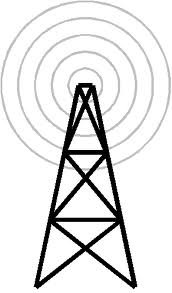|
|
|
March
9, 2011
Reducing the Effects of RF Obstructions with Artifical Impedance Surface (AIS) Technology
Christopher Magnan .
Bio:
Mr. Christopher Magnan is an RF Engineer at Antenna Research
Associates (ARA) in Beltsville, MD, dividing his time between antenna design
and business development. Prior to ARA,
Mr. Magnan developed signals acquisition and geolocation systems at L-3 Communications
and supported technology developed at Fort Monmouth, NJ while employed at Booz
Allen Hamilton. He received his Bachelor of Science in Electrical Engineering
from Northeastern University, his Masters of Engineering in Electrical
Engineering from the A. J. Clark School of Engineering at the University of
Maryland, College Park, and his MBA from the R. H. Smith School of Business at
the University of Maryland, College Park.
Presentation
Contact the Speaker

Abstract:
Antenna
Research Associates (ARA) and Hughes Research Laboratories (HRL) have developed
a solution to mitigate signal degradation on UAV’s caused by local obstructions
including the landing gear and engine cowlings. The technology solution, Artificial
Impedance Surface (AIS), has been developed to control the propagation of
surface waves for tailoring EM radiation and scattering. Surface waves can be made to radiate at a
prescribed rate and angle by modulating a surface’s wave propagation index. The propagation index profile has been
determined using microwave holography; this propagation index using artificial
impedance structures, which are a type of metamaterial. In the approach ARA and HRL have developed, a
PCB with an artificial impedance surface is integrated onto the obstructed
surface.
Artificial impedance surface technology offers the
capability to control structural radiation and scattering properties. It will
significantly reduce the challenge of integrating antennas on existing army
airborne platforms where structures interfere
with antenna placement, and it will potentially revolutionize next generation
airborne platform design by providing a new conformal, low-mass means of
integrating radiating apertures into the skins of airborne platforms. This new
approach to integrated EM structures not only enables improved antenna/sensor
performance by tailoring the entire platform’s EM radiation, but also improves
the airborne platform’s energy efficiency and range by reducing aerodynamic
drag and mass associated with current antenna solutions. Applying this
technology to Army airborne platforms could yield significant increases to
airborne platform sensor coverage area and range, thus increasing overall
system effectiveness.
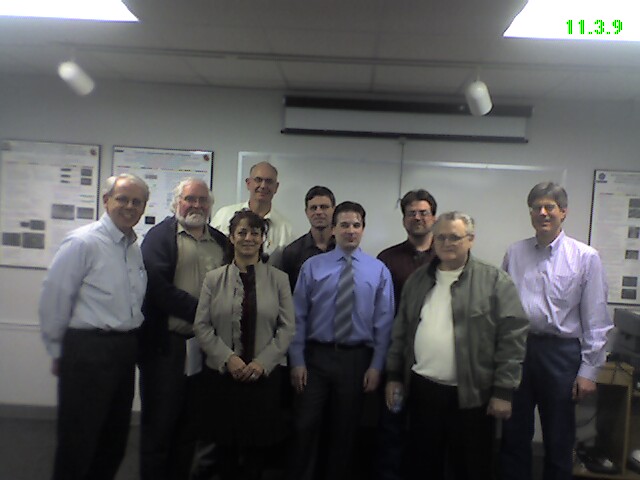
|
|
|
|
|
April
18, 2011
Electromagnetic Scattering from Arbitary Bodies Using Rao-Wilton-Glisson (RWG) functions--An Overview
Dr. Sadasiva Rao
Bio:
Sadasiva M. Rao received the
Bachelors degree in electrical communication engineering from Osmania
University in 1974, Masters degree in microwave engineering from Indian
Institute of Sciences in 1976, and Ph.D. degree with specialization in
electromagnetic theory from University of Mississippi in 1980.
Dr. Rao served as an Assistant Professor in the Department of Electrical
Engineering, Rochester Institute of Technology from 1980 to 1985, Senior
Scientist at Osmania University from 1985 to 1987, and as a Professor in the
Department of Electrical and Computer Engineering, Auburn University from 1988
to 2009. He also held visiting Professorships at University of Houston (1987to
1988), Osmania University, and Indian Institute of Science. Presently, he is
with the Radar Division, Naval Research Laboratory, Washington, DC. Dr. Rao
worked extensively in the area of numerical modeling techniques as applied to
Electromagnetic/Acoustic Scattering. He and his team at the University of
Mississippi, were the original researchers to develop the planar triangular
patch model and to solve the problem of EM scattering by arbitrary shaped
conducting bodies. For this work, he received the best paper award for the
period 1979 to 1981 from SUMMA Foundation. He published/presented over 150
papers in international journals/conferences. For his contributions in
numerical electromagnetic problems, he was awarded the status of Fellow of
IEEE. Further, he was recognized as a HIGHLY CITED RESEARCHER by Thomson ISI in
2001.
Dr. Rao's research interests are in
the area of numerical methods applied to antennas and scattering.
Presentation
Contact the Speaker
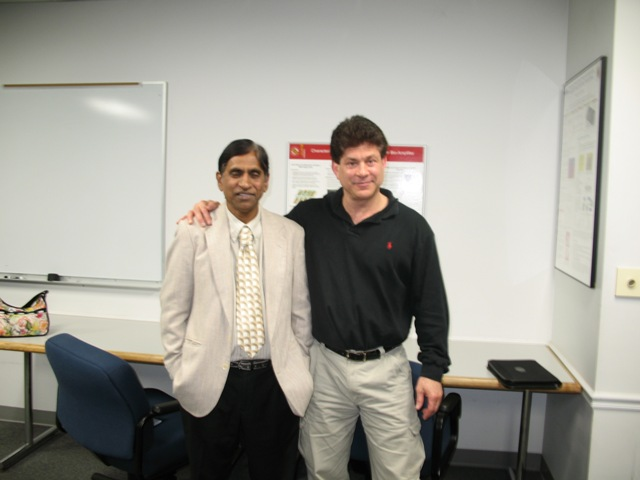
Abstract:
For scattering problems concerning arbitrary
shaped bodies, the method of moments (MoM) has provided a practical means of
solution using surface integral equations. Although there exist several
numerical procedures to solve such MoM problems, the most popular of such
schemes employs triangular patch modeling and Rao-Wilton-Glisson (RWG) vector
basis functions. In this work, we examine the application of RWG functions for
various situations, in frequency domain as well as in time domain involving: a)
only PEC bodies, b) only dielectric bodies, and c) a combination of both
conductor/dielectric bodies. We investigate various expansion and testing
schemes adopted for successful numerical implementation of the afore mentioned
problems and analyze the circumstances necessitated to develop those schemes.
We also look at a few recent numerical procedures which further extend the
applicability of these functions and the method of moments itself to
electrically large problems.
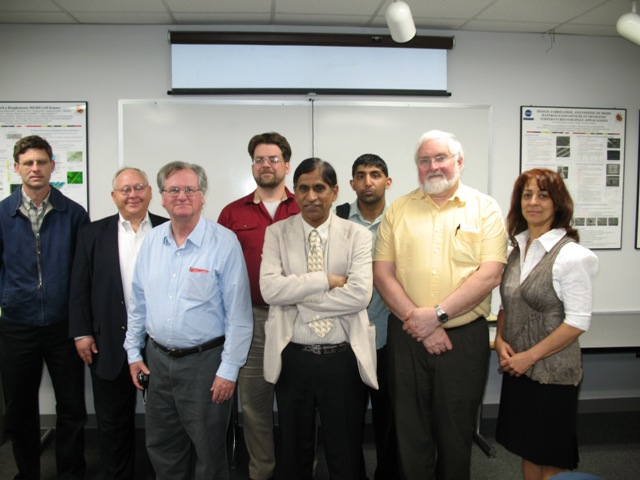
|
|
|
|
|
May
18, 2011 |
|
|
|
|
FDTD Analysis of In-body RF Communications Using Basic
MATLAB Package
|
|
|
|
|
|
|
|
|
|
Professor
Sergey N. Makarov and Gregory M. Noetscher |
|
|
|
|
Bios:
Sergey N. Makarov (M’98–SM’06) earned his B.S./M.S./Ph.D./Dr. Sci. degrees at the St.
Petersburg (Leningrad) State University, Russian Federation – Faculty of
Mathematics and Mechanics. Dr. Makarov joined Institute of Mathematics and
Mechanics at State St. Petersburg University in 1986 as a researcher and then
joined the Faculty of State St. Petersburg University where he became a full
professor (youngest full professor of the faculty) in 1996. In 2000 he joined
the Faculty of Department of Electrical and Computer Engineering at Worcester
Polytechnic Institute, MA where he became a full professor and director of the
Center for Electromagnetic Modeling and Design in 2008. His current research
interests include applied antenna design and computational electromagnetics.
Gregory M. Noetscher (S’11) was born in
Syracuse, NY. He received the B.S.
degree in biomedical engineering and the M.S. degree in electrical engineering
from Worcester Polytechnic Institute in 2000 and 2005, respectively. Since
2003, Mr. Noetscher has worked on the Airdrop Technology Team at the U.S. Army
Natick Soldier Research, Development and Engineering Center in Natick, MA Currently,
Mr. Noetscher is working toward his PhD degree. His research interests include
numerical modeling and applied electromagnetics.
Presentation
Contact the Speaker
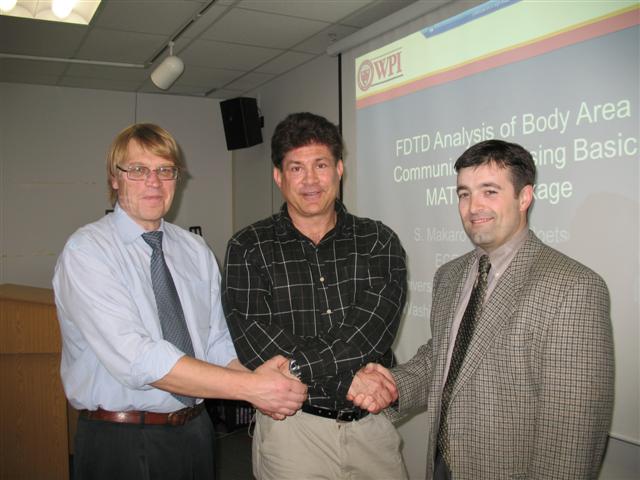
|
|
|
|
|
Abstract:
A classic FDTD solver
(Yee algorithm on a rectangular grid) capable of modeling of a TX/RX antenna
link (small dipole, loop, patch, PIFA antennas) in the vicinity or inside a
human body model is implemented in MATLAB®. We present results for standard
(Ansoft/Ansys HFSS) and custom body meshes obtained with WB4 whole body scanner
manufactured by Cyberware. Those meshes are projected onto the base rectangular
grid using interpolation of the relative dielectric permittivity between FDTD
nodes. The effect of different body shapes and body organs is quantified at certain
VHF ad UHF frequencies. Special attention is paid to a 402 MHz carrier.

|
|
|
|
|
June
17, 2011
|
|
|
|
|
Design, Fabrication, Simulation and Testing of Flexible Bow-Tie
Antennas
|
|
|
|
|
Professor Constantine Balanis
|
|
|
|
|
Bio:
Constantine A. Balanis (S'62 - M'68 -
SM'74 - F'86 – LF'04) received the BSEE degree from Virginia Tech, Blacksburg,
VA, in 1964, the MEE degree from the University of Virginia, Charlottesville,
VA, in 1966, and the Ph.D. degree in Electrical Engineering from Ohio State
University, Columbus, OH, in l969. From 1964-1970 he was with NASA Langley
Research Center, Hampton VA, and from 1970-1983 he was with the Department of
Electrical Engineering, West Virginia University, Morgantown, WV. Since 1983 he has been with the Department of
Electrical Engineering, Arizona State University, Tempe, AZ, where he is now
Regents' Professor. His research interests are in computational
electromagnetics, flexible antennas and High Impedance Surfaces (HIS/EBGs), smart
antennas, and multipath propagation. He
received in 2004 a Honorary Doctorate from the Aristotle University of
Thessaloniki, the 2005 IEEE Antennas and Propagation Society Chen-To Tai
Distinguished Educator Award, the 2000 IEEE Millennium Award, the 1996 Graduate
Mentor Award, Arizona State University, the 1992 Special Professionalism Award
from the IEEE Phoenix Section, the 1989 IEEE Region 6 Individual Achievement
Award, and the 1987-1988 Graduate Teaching Excellence Award, School of
Engineering, Arizona State University.
Dr. Balanis is a Life Fellow of the
IEEE. He is Chair, Awards and Fellows
Committee, IEEE Antennas and Propagations Society (2009-present). He has served as Associate Editor of the IEEE Transactions on Antennas and
Propagation (1974-1977) and the IEEE Transactions on Geoscience and Remote
Sensing (1981-1984), as Editor
of the Newsletter/Magazine for the
IEEE Geoscience and Remote Sensing Society (1982-1983), as Second
Vice-President (1984) and member of the Administrative Committee (1984-85) of
the IEEE Geoscience and Remote Sensing Society, and as Distinguished Lecturer
(2003-2005), Chairman of the Distinguished Lecturer Program (1988-1991) and
member of the AdCom (1992-95, 1997-1999) of the IEEE Antennas and Propagation
Society. He is the author of Antenna Theory: Analysis and Design (Wiley, 2005, 1997, 1982), Advanced Engineering Electromagnetics (Wiley, 1989) and Introduction to Smart Antennas (Morgan and Claypool, 2007), and
editor of Modern Antenna Handbook
(Wiley, 2008) and for the Morgan & Claypool Publishers, series on Antennas
and Propagation series, and series on Computational
Electromagnetics.
Presentation
Contact the Speaker
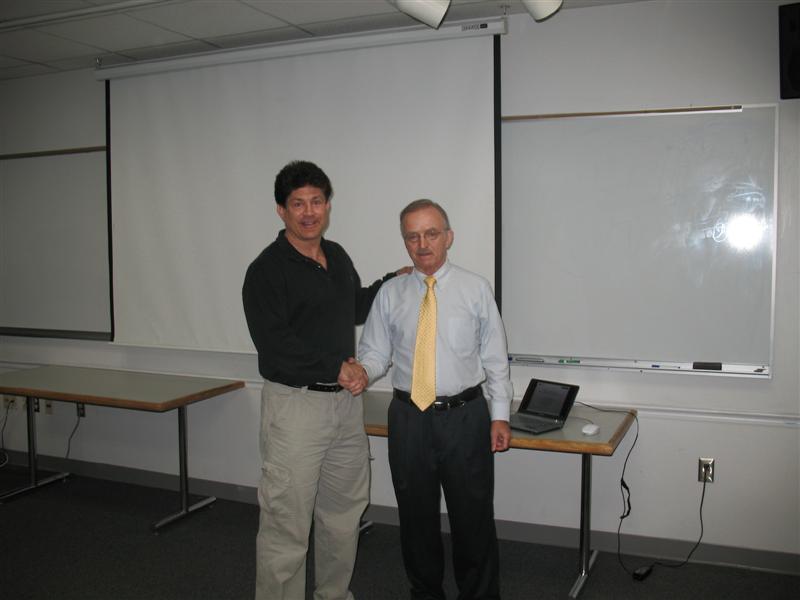
Abstract:
The presentation will focus on the design, fabrication,
simulation and measurements of two different flexible bow-tie antennas: a
conventional and a modified one with reduced metallization. The antennas are mounted on a flexible
substrate which is fabricated at the Flexible Display Center (FDC) of Arizona
State University (ASU). The substrate is
heat stabilized polyethylene naphthalate (PEN) which allows the antennas to be
flexible. The antennas are fed by a
microstrip-to-coplanar feed network balun.
The reduction of the
metallization is based on the observation that the majority of the current
density is confined towards the edges of the regular bow-tie antenna. Hence the center parts of the conventional
bow-tie antennas are removed without compromising significantly its
performance. The return losses and radiation patterns of the antennas are
simulated with HFSS and the results are compared with measurements, for bow-tie
elements on flat and curved surfaces.
The impact of the curvature is also examined. The comparisons show that there is an
excellent agreement between the simulations and measurements for both
cases. Furthermore, the radiation
performance of the modified bow-tie antenna is verified to be very close to
those of the conventional bow-tie by simulations and measurements.
In addition to the radiation
characteristics of the antennas, the effects of the feeding structure and the
conductor losses on the radiation performance of the antennas will be
discussed.
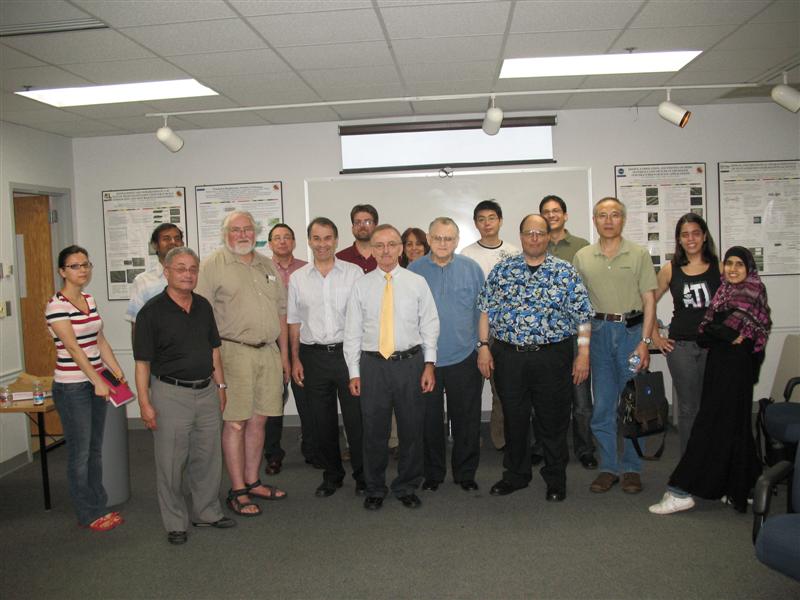
|
|
|
|
|
July 20, 2011 |
|
|
|
|
Low Cost ESAs for Army Applications
|
|
|
|
|
Dr. Steve Weiss
|
|
|
|
|
Bio: |
|
|
|
|
Dr. Steven
J. Weiss graduated from The Rochester Institute of Technology with a Bachelor’s
Degree in Electrical Engineering in 1985 and from the George Washington
University with a Doctorate of Science (DSc.) in Electrophysics in 1995.
He
presently heads the antenna team at the Army Research Lab working on the
development of antenna systems for applications as diverse as radar, satellite
communications, and terrestrial communications. His research areas also
include specialized antennas for military applications for which he has been
recognized for his outstanding contributions. His recent research interests
have investigated metamaterial enhancements to antennas for military
applications and the in-situ modeling to optimize antenna placement on
platforms.
Dr. Weiss
has taught evenings at the Johns Hopkins University since 2002 instructing
courses in Antenna Systems (525.418) and Advanced Antenna Systems (525.738),
and Intermediate Electromagnetics (525.405).
Dr. Weiss
is a senior member of the IEEE holding memberships in the both the Antennas and
Propagation and the Education Societies. He is also a member of the
International Union of Radio Science (URSI) and the Applied Computational
Electromagnetics Society (ACES.) Dr. Weiss has published numerous conference
and journal papers with these professional affiliations. He is a fellow of the
Washington Academy of Science and is a licensed professional engineer with the
states of Maryland and Delaware
Presentation
Contact the Speaker
|
|
|
|
|
|
|
|
|
|
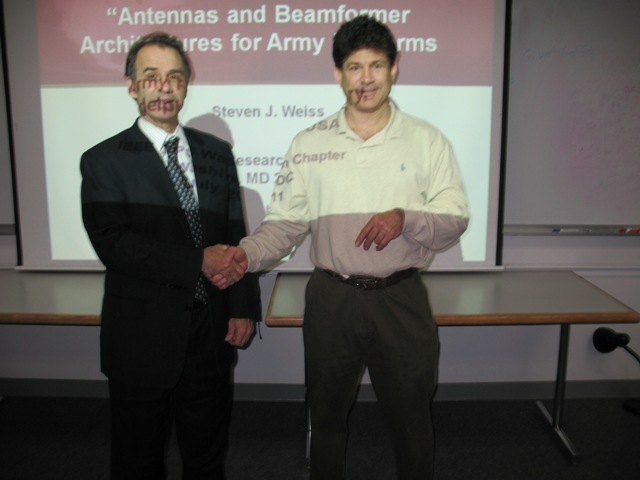
|
|
|
|
|
Abstract:
|
|
|
|
|
Over the years the Army Research
Laboratory has designed, prototyped and demonstrated a full spectrum of
affordable scanning antenna concepts for multiple applications. These
concepts include a traditional electronic phase shifter for X-band compact
network radars, Rotman lens beamformers for Ku band Terrestrial Communications
and Ka band Multifunction RF systems and a W-band switch beam antenna for
robotic perception. This talk will give an overview of ARL developed
beamformers as well as a discussion of some unique antenna designs created by
the antenna team at the lab.
|
|
|
|
|
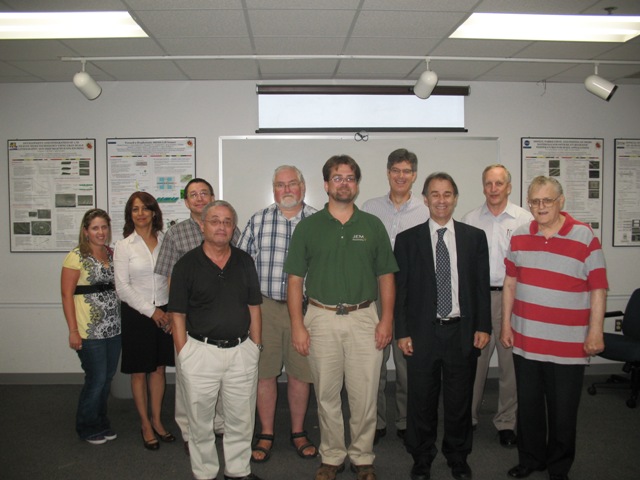
|
|
|
|
|
|
|
|
|
|
August 23, 2011
|
|
|
|
|
Seminar 1: Terminal antenna design: practical
considerations
Seminar 2: Challenges in practical design of planar arrays
Dr.
Marta Martínez-Vázque
|
|
|
|
|
Bio: |
|
|
|
|
Nowadays,
the access to mobile communications not only through mobile telephones, but
also other kind of portable devices such as notebooks or PDAs, equipped with
PCMCIA cards, allows providing almost universal connectivity, with access to
public or private networks. Therefore, both cellular standards, such as the GSM
family and third generation standards such as UMTS, as well as unlicensed
networks, like WLAN, should be accessible with a single device. However, the limited space foreseen for the antenna and the small
overall size of the terminal are often the reason of the narrow band
characteristics of the resulting antennas. This problem becomes even more
serious when a multiband or an ultra-wideband antenna has to be designed. Also,
only a careful design of the antenna taking into account the interaction both
with the handset components and the human user can lead to satisfying solutions
that fulfil the given requirements for mobile communications handsets. Their
design is, however, no trivial task due not only to the extensive requirements
of modern antennas but also to plethora of physical factors that impinge on
their performance, such as the close proximity of electronic components.
However, in the design of antennas for
commercial applications, the designer has to take into account many issues not
directly related to the antenna itself. Antenna engineers have to interact with
other departments, to satisfy all the requirements in terms of, for example,
mechanical stability, aesthetical design or compliance testing. Thus, the
design must be able to adapt the antenna concept to eventual changes in the
device or the specifications. Although the use of powerful software packages
has allowed to precisely simulate the antennas in such a complex environment,
they are useless without an in-depth knowledge of electromagnetic theory and
experience in solving such problems.
Dr. Martínez-Vázquez has been involved in
the design of antennas for mobile communications both from the academic and the
industrial point of view, which allows her to have a global view on the
problems related to this topic.
|
|
|
|
|
Presentation1
Presentation2
|
|
|
|
|
Contact the Speaker |
|
|
|
|
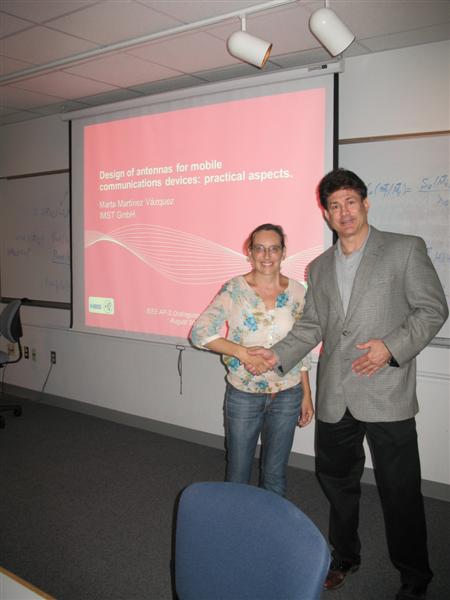
|
|
|
|
|
Abstract:
|
|
|
|
|
1. Nowadays,
the access to mobile communications not only through mobile telephones, but
also other kind of portable devices such as notebooks or PDAs, equipped with
PCMCIA cards, allows providing almost universal connectivity, with access to
public or private networks. Therefore, both cellular standards, such as the GSM
family and third generation standards such as UMTS, as well as unlicensed
networks, like WLAN, should be accessible with a single device. However, the limited space foreseen for the antenna and the small
overall size of the terminal are often the reason of the narrow band
characteristics of the resulting antennas. This problem becomes even more
serious when a multiband or an ultra-wideband antenna has to be designed. Also,
only a careful design of the antenna taking into account the interaction both
with the handset components and the human user can lead to satisfying solutions
that fulfil the given requirements for mobile communications handsets. Their
design is, however, no trivial task due not only to the extensive requirements
of modern antennas but also to plethora of physical factors that impinge on
their performance, such as the close proximity of electronic components.
However, in the design of antennas for
commercial applications, the designer has to take into account many issues not
directly related to the antenna itself. Antenna engineers have to interact with
other departments, to satisfy all the requirements in terms of, for example,
mechanical stability, aesthetical design or compliance testing. Thus, the
design must be able to adapt the antenna concept to eventual changes in the
device or the specifications. Although the use of powerful software packages
has allowed to precisely simulate the antennas in such a complex environment,
they are useless without an in-depth knowledge of electromagnetic theory and
experience in solving such problems.
Dr. Martínez-Vázquez has been involved in
the design of antennas for mobile communications both from the academic and the
industrial point of view, which allows her to have a global view on the
problems related to this topic.
|
|
|
|
|
2. The development of new multimedia services and intelligent sensor
systems is progressing at a rapid pace and requires the use of agile antenna
frontends that are compact, highly efficient and cost-effective. These antennas
are rarely off-the-shelf solutions. On the contrary, custom-tailored solutions
are usually required in order to optimise the performance, and facilitate the
integration into the final product.
In many applications, the best compromise for an antenna solution with
respect to cost and performance is a planar array. In general, a planar array can
be defined as an antenna in which all of the elements are situated in one
plane. The antenna elements themselves can be patches or other planar or buried
structures. The range of applications of planar arrays include agile
RF-frontends for mobile satellite terminals, radar systems for automotive and
security applications, and millimetre wave point-to-point or
point-to-multipoint radio links for multimedia wireless networks.
Real-life communications systems can include antenna arrays with only a
limited number of transmitters and receivers as well as very large arrays with
hundreds of receive and transmit channels. A skilful symbiosis of industrial
development and innovative research projects is the key to provide cost-effective
products. Some typical applications will be described in the next sections.
Considerable experience is required for the design and realisation of
planar antenna arrays at microwave frequencies, especially when broadband
solutions are demanded. It is not only necessary to develop innovative concepts
beyond the standard patch design, but it also becomes unavoidable to cope with
material and manufacturing tolerances when realising the antennas on soft and
hard substrates. Special care has also to be invested in the RF-feeding network
and the transition between antenna and RF-circuitry, as the latter can become a
bottleneck at high frequencies, hence limiting the available bandwidth.
In order to provide cutting-edge solutions, it is important not only to
develop systems based on state-of-the art antenna concepts. Fast and highly
accurate EM solvers are indispensable tools to simulate the whole antenna
system. Access to prototyping tools and accurate measurement facilities are
also required. The seamless integration of all these services helps reduce the
number of iterations to obtain high-performance antennas, thus leading to reduced
development time. A complete, industrial solution for complex planar arrays
must cover the whole development chain, starting with the conceptual design and
the development of new concepts and solutions, going through the prototyping
and optimisation process, including antenna characterisation and diagnosis, up to
the preparation of line production and qualification phase. Some of the key
steps will be discussed in this talk.
|
|
|
|
|
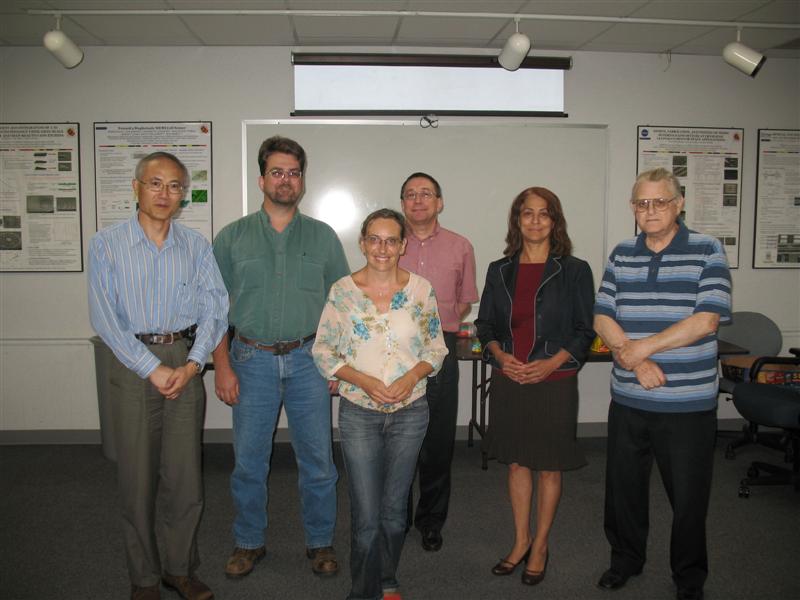
|
|
|
|
|
|
|
|
|
|
September 16, 2011
|
|
|
|
|
Emerging Conformal, Flexible Antenna Technologies for UAVs and
Morphing Structures
|
|
|
|
|
BIO
Dr. Yakup Bayram is a CEO
& Chief Technology Officer at PaneraTech, Inc., which is specialized in
conformal antennas, wireless sensors and navigation solutions. Prior to his
position at PaneraTech, Dr. Bayram was with The Ohio State University
ElectroScience Laboratory (OSU-ESL) at Senior Research Associate capacity. During
his tenure at OSU-ESL, Dr. Bayram has participated in and led research programs
spanning conformal antennas to wireless sensors, electromagnetic interference, and
wireless communications and propagation. He also served as the Principal
Investigator for research and development efforts for two Air Force and NAVAIR
funded projects for wireless strain
sensing on Jet engine compressor and turbine blades. Dr.
Bayram also served as the program coordinator for the AFOSR GameChanger program
whose objective was to develop “Multifunctional Hybrid Composite Structures for
Load Bearing Antennas for Unmanned Aerial Vehicles.”
Dr. Yakup Bayram also made
significant contributions to the development of high frequency computational
modeling of Electromagnetic Interference and
Compatibility. He is author of a book on the subject "Computational
Methods for High Frequency Electromagnetic Interference” and one of his
publications received a prestigious IEEE Leo L. Beranek award in this field. He
has over 40 journals and conference publications on topics ranging from
innovative antennas to wireless sensors.
Dr. Bayram received his B.S.
in Electrical Engineering from Bilkent University, Turkey in 2001 and M.S. and
Ph.D. degrees in Electrical and Computer Engineering from The Ohio State
University, USA, in 2004 and 2006, respectively. He also received his M.B.A
degree from Fisher College of Business,
The Ohio State University in 2007.
Dr. Bayram is a senior
Member of IEEE, and recipient of
the 2005 IEEE Leo L. Beranek Award for innovative contributions to the
field at IEEE International EMC conference in Chicago. He is also the recipient
of 2001 IEEE Regional Activities Achievement Board Award. He
is an invited reviewer for six major research journals and books by
Wiley&Sons Publisher. Dr. Bayram is also a recipient of merit-based Ashland
Fellowship and The Frank Joseph Thomas Memorial Scholarship from Fisher College
of Business.
|
|
|
|
|
Presentation
|
|
|
|
|
Contact the Speaker
|
|
|
|
|
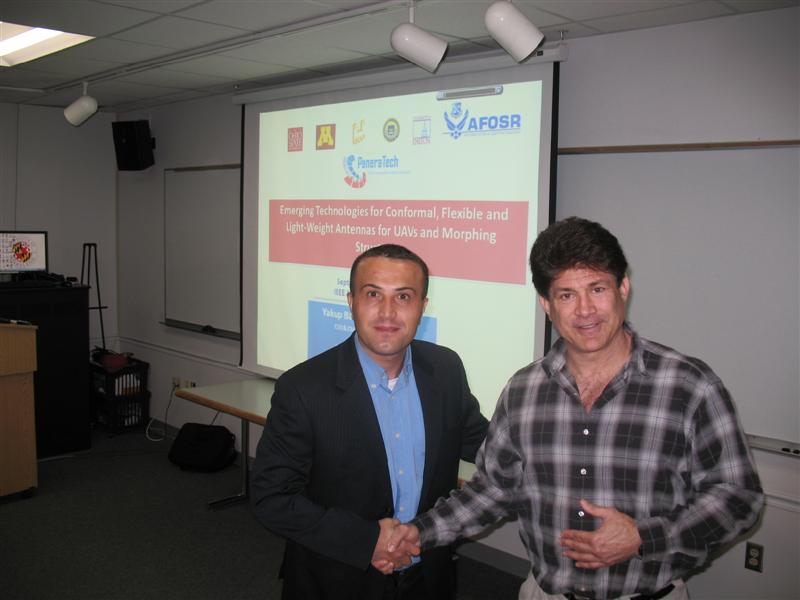
|
|
|
|
|
ABSTRACT
Conformal and light-weight antennas
are gaining significant interest with the proliferation of Unmanned Aerial
Vehicles (UAVs). There has been limited success with integrating low frequency
antennas into the UAV airframe. Low frequency antennas present severe technical
challenges since they claim major real estate on the limited UAV airframe due
to large wavelengths at low frequencies. Furthermore, increased co-site and
co-channel interference due to tightly packed antennas on a limited real estate
leads to further challenges integrating these antennas on the UAV platform.
Therefore, conformal antennas are key to not only utilizing the UAV real estate
more optimally but also reducing interference; thus, improving the antenna
performance. These structures also enable device miniaturization via 3D
integration of the antenna into a host structure. For example, conformal antennas can be woven into airframes and reinforced to become
load-bearing as well.
This
talk will discuss our latest developments regarding conformal and flexible
multi-layer antenna structures for UAVs and morphing structures. We will present several technologies and specifically
discuss flexible antenna structures based on Carbon Nanotubes (CNTs) printed on
polymers, e-textiles integrated with polymers, and conductive fibers
embroidered on multi-layer polymer structures. The talk will discuss the theory,
design examples and sample antennas built and tested at the compact range at
OSU-ES |
|
|
|
|
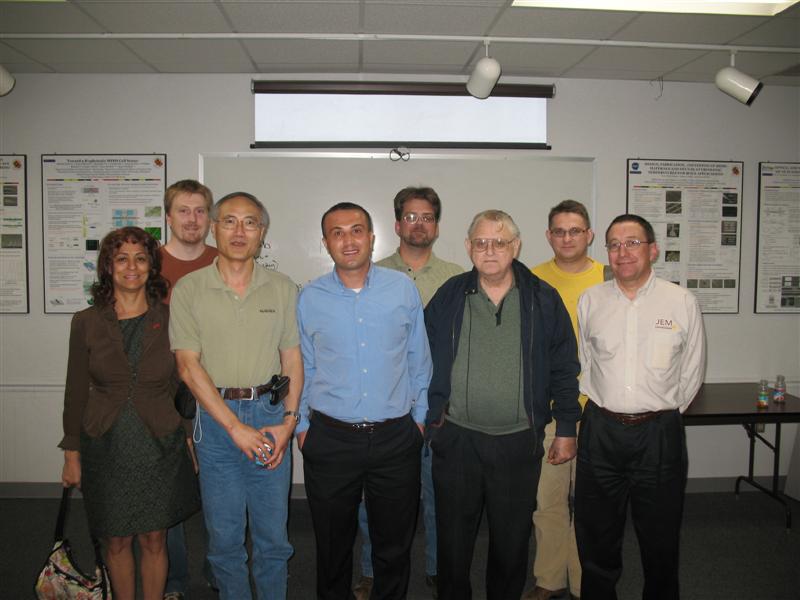
|
|
|
|
|
|
|
|
|
|
October 19, 2011 |
|
|
|
|
Noise Analysis and Low-noise Design for Compact Multi-antenna Receivers: A
Communicaton Theory Perspective |
|
|
|
|
Bio
Carlo
P. Domizioli (S'03-M'09) was born in Luton, U.K., on Nov. 7, 1980. He received
the B.S. degree in electrical engineering from Tennessee Technological
University, Cookeville, in May 2005, and the Ph.D. degree in electrical
engineering from North Carolina State University, Raleigh, in Dec. 2009. Since
Aug. 2009 he has been employeed as a communication systems engineer for
Northrop Grumman Information Systems in Fairfax, VA. His areas of interest
include channel modeling and receiver design for MIMO and OFDM wireless
communication systems.
|
|
|
|
|
Presentation
|
|
|
|
|
Dissertation
|
|
|
|
|
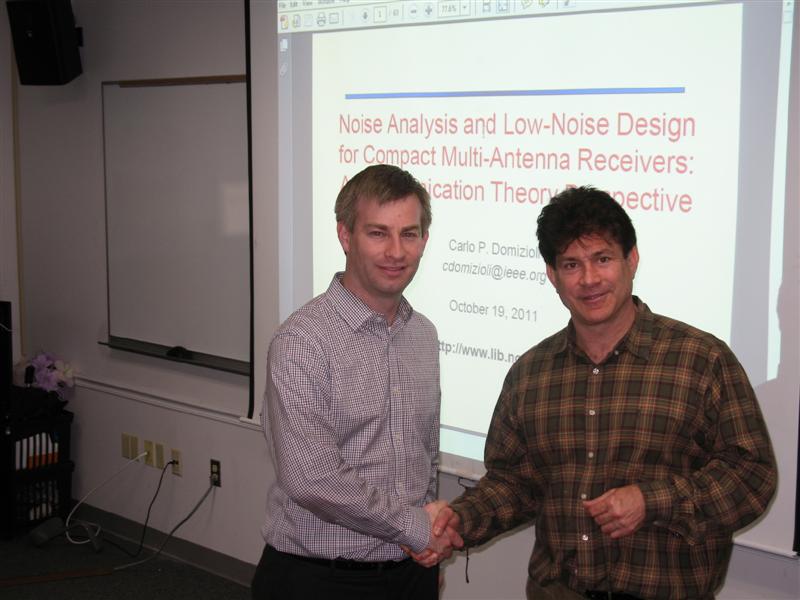
|
|
|
|
|
Abstract
Multiple-input,
multiple-output (MIMO) systems combine the deployment of multiple antennas at
both the transmitter and receiver with sophisticated signal processing to
improve the performance of wireless communications. As with any communication
system, developing an accurate yet mathematically tractable channel model is
essential to analyzing the performance of actual systems. Prior studies of MIMO
channel modeling have provided detailed models for fading correlation -- either
due to the propagation environment or through mutual coupling between the
antennas -- and how this correlation affects performance. On the other hand,
relatively little attention has been paid to the noise correlation. In this
talk we consider noise analysis and low-noise design for compact MIMO
receivers. We begin by extending a circuit model for mutual coupling to include
noise generated by theantennas, front-end amplifiers, and other components.
Through analytical and numerical examples we demonstrate that the noise may be
correlated, and that different noise sources may impact performance in
profoundly different ways. Finally, we derive low-noise design theorems for
MIMO front-ends from communication-theoretic principles
|
|
|
|
|

|
|
|
|
|
|
|
|
|
|
November 16, 2011 |
|
|
|
|
Directional Wireless Communications
Networks
|
|
|
|
|
Presentation
|
|
|
|
|
contact the speaker
|
|
|
|
|
Bio
Christopher C. Davis is
Professor of Electrical and Computer Engineering at the University of Maryland,
College Park. He received the B.A. degree (with Honors) in Natural Sciences
from the University of Cambridge in 1965, the M.A. degree from the University
of Cambridge in 1970, and the Ph.D. degree in Physics from the University of
Manchester in 1970. From 1973-1975 he was a Instructor/Research Associate at
Cornell University, and from 1982-83 was a Senior Visiting Fellow at the
University of Cambridge. He has been a recipient of the following Honors and
Awards: University of Maryland
Distinguished Scholar-Teacher, 1989-90; Fellow of the Institute of Physics,
1989; AT&T/ASEE Award for Excellence in Engineering Education,1990; Fellow
of the IEEE, 1993; Invention of the Year Award in Information Technology,
University of Maryland, 2000. Professor Davis is the author of the widely used
text “Lasers and Electro-Optics,” published by Cambridge University Press, and
co-author with Jack Moore and Mike Coplan of the best selling text “Building
Scientific Apparatus,” recently published in its 4th edition by Cambridge University
Press.
He is also author or co-author of 14
chapters in books, over 205 refereed journal articles and 290 conference
papers, and is the holder of twelve awarded and several pending patents. He is
Conference co-Chair of the SPIE Free Space Laser Communications Conference, and
is a frequent invited lecturer both nationally and internationally.
He has served as a scientific
consultant to several US Government agencies and industry. He is a member of
the IEEE Standards Coordinating Committee SCC-34 SC2, which deals with RF
exposure from wireless devices.
Currently active research includes
optical and RF directional wireless, real-time advanced surveillance systems
with “event” detection, the optical properties of nanostructures where surface
plasmons can be excited, near-field scanning optical microscopy, laser
interferometry, dielectrometry, fiber sensors and biosensors, magnetooptics,
optical trace detection, atmospheric turbulence, optical communication systems
and devices, and biophysics.
His past research has covered gas
lasers, photon counting, chemical lasers, molecular relaxation processes,
diode-pumped solid-state lasers, laser noise and instabilities, injection
locking of broad area laser diodes, nonlinear imaging of ferroelectric and
ferromagnetic materials, and studies of the biological effects of non-ionizing
radiation
|
|
|
|
|
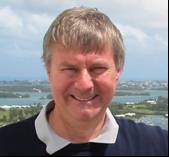
|
|
|
|
|
Abstract
Broadcast
wireless networks have no fixed topology and suffer from several problems. Data
from a node in the network that is intended for another node in the network
becomes in essence interference at other nodes for which the data is not
intended. Broadcast networks do not scale. Directional wireless networks use technologies
that range from optical to radio and send data only to nodes for which it is
intended. They are essentially infinitely scalable and can have an extremely
low probability of intercept and detection. Omnidirectional transmissions waste
energy, and are detectable by any node within range. Consequently, such
networks are easily detectable, although actual data may not be detectable if
encrypted. Omnidirectional wireless networks do not use the spatial or spectral
domains as efficiently as hybrid networks, which use a directional wireless
backbone and omnidirectional clusters of edge nodes. Such networks have defined
topologies, which can be controlled to optimize the performance of the network.
This optimization can provide mobility management as well as providing a secure
high data rate backbone. This talk will discuss some of the challenges involved
in implementing these hybrid networks, including topics such as topology
control, pointing, acquisition, and tracking of directional links, and novel
methods of simulation.
|
|
|
|
|
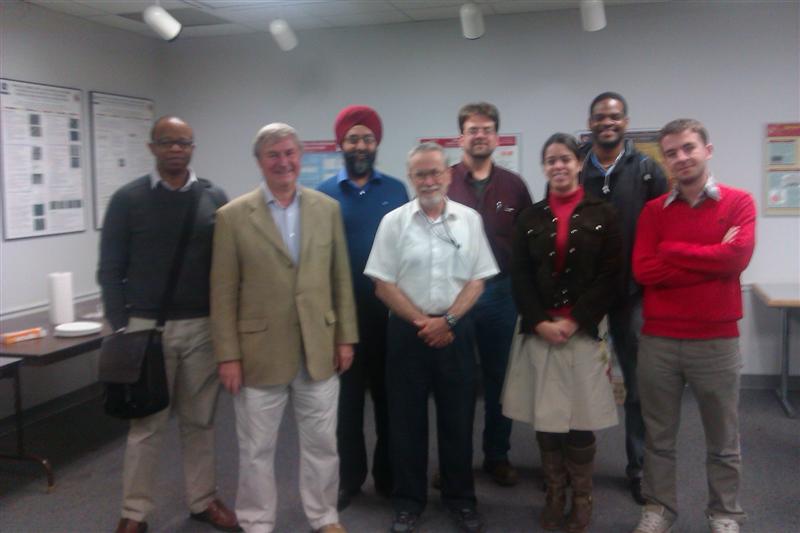
|
|
|
|
|
December 12, 2011
|
|
|
|
|
Millimeter Wave Photonics: Design, Fabrication, and
Demonstration |
|
|
|
|
Presentation
|
|
|
|
|
contact the speaker
|
|
|
|
|
Bio
Dennis Prather began his
professional career by joining the US Navy in 1982, where he still serves in
the reserves as an Engineering Duty Officer (0-5). After active duty, he
received the BSEE, MSEE, and PhD from the University of Maryland in 1989, 1993,
and 1997, respectively. During this time he worked as a senior researcher
engineer for the Army Research Laboratory, where he performed research on both
optical devices and architectures for information processing. His efforts
included work on the modeling, design, and fabrication of meso-scale optical
elements and their integration with active opto-electronic devices, such as
VCSELS, IR FPAs and semiconductor lasers. During this work he developed computational
electromagnetic models for the analysis of aperiodic-subwavelength and
nano-scale photonic devices. In 1997 he joined the Department of Electrical and
Computer Engineering at the University of Delaware. Currently he is the College
of Engineering Alumni Distinguished Professor and his research focuses on both
the theoretical and experimental aspects of active and passive nano-photonic
elements and their integration into various subsystems. To achieve this, his
lab develops and refines coupled computational electromagnetic and quantum
mechanical models as well as the associated nano-fabrication (with a specialty
in electron beam lithography) and integration processes necessary for their
demonstration. Specific devices and applications include: subwavelength
structures, photonic crystal devices, high frequency optical modulators,
meta-materials, and RF-Photonics.
Professor Prather is currently an
Endowed Professor of Electrical Engineering, he is a senior member of the IEEE,
Fellow of the Society of Photo-Instrumentation Engineers (SPIE) and a Fellow of
the Optical Society of America (OSA). He received the Outstanding Junior
Faculty in the College of Engineering in 2000, the William J. Kastner Award for
Naval Engineering Excellence, in 2000, as well as the National Science
Foundation CAREER Award, in 1999 and the Office of Naval Research Young
Investigator Award, in 1999. He has authored or co-authored over 300 scientific
papers, holds over 40 patents, and has written 10 books/book-chapters.
|
|
|
|
|

|
|
|
|
|
Abstract.
In this talk Dr. Prather
will present the development of an imaging system for
millimeter waves (mmWs) as well as many of its advantages and applications in
the defense and security markets. Imaging in the mmW spectrum offers many of
the advantages common to infrared imaging, but allows for the ability to see
through obscurants, such as blowing sand, fog, dust, smoke, and light rain. It
also offers the ability to see through certain types of materials, like outer
garments, fiberglass, drywall, and others. In the course of this talk, Dr. Prather will discuss some
of the unique attributes of mmWs and some of the underlying technologies used
to capture and process these signals into images. In particular, his approach
involves the use of high-frequency photonic modulators, which convert mmWs onto
and optical signal that can be more easily imaged. This requires the
heterogeneous integration of organic, inorganic, RF photonic, metamaterials and
optoelectronic devices. Component design and integration will be presented in
the context of realizing integrated RF-Photonic modules that contain
ultra-broad band antennas, low noise amplifiers, and photonic phase-only
modulators. Fully integrated systems working at 35 and 94GHz are characterized
and presented.
|
|
|
|
|
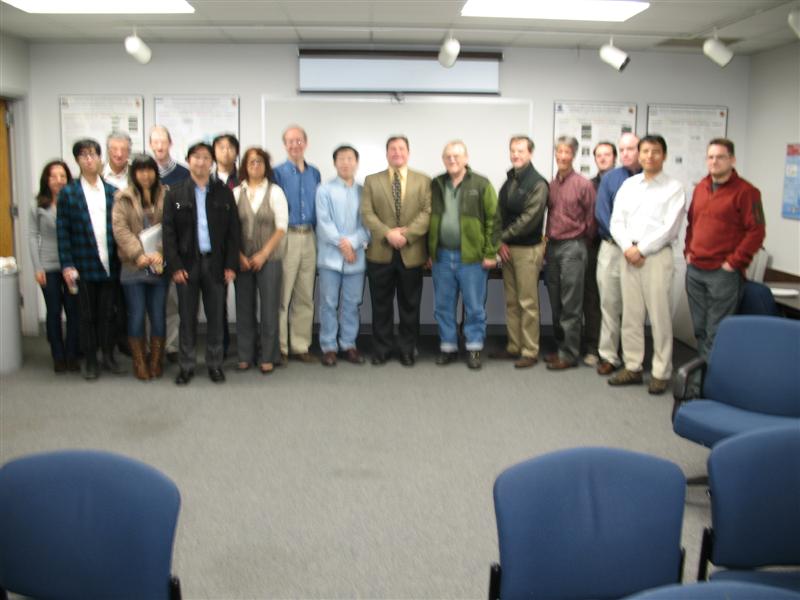
|
|
|
|
|
|
|
|
|
|




